The Cornell Lab Bird Academy › Discussion Groups › Joy of Birdwatching › Activities: Different Seasons, Different Birds
-
Activity 2 - Westchester, NY Year-round: Red-bellied Woodpecker, Blue Jay, Black-capped Chickadee Visitors: Yellow-rumpled Warbler, Scarlet Tanager, Baltimore Oriole Activity 3 Male Goldfinch: Winter- drab brown colors, Summer- bright yellow Common Loons: Winter- partial collar, brownish, Summer- bright collar and checkered-board back Activity 4 - Croton Point Park, Westchester, NY A birding hotspot Using ebird.org, today(May 15th), some of the species seen are: Purple Martin Canada Greece Least Flycatcher Blue-headed Vireo Northern Rough-winged Swallow European Starling Gray Catbird Swainson ‘s Thrush Yellow Warbler Chestnut-sided Warbler Indigo Bunting and much more! A lot of these will not be here in the winter- purple martins, warblers, Indigo Bunting!!!
-
Hi - Activity One Northern Cardinal with Blackburnian Warble- Really interesting to use the animated abundance maps. Cardinals are around here (NY) all year while the Blackburnian Warbler leaves to go back home to South America. Scarlet Tanager with Western Tanager- the Scarlet only migrates on the east coast while the Western Tanager stays on the west coast. Ruby-throated Hummingbird with Rufous Hummingbird - another surprise- east vs west coast migrations Sandhill Crane with Yellow-bellied Flycatcher- both birds migrate much further north than the others mentioned. The Sandhill Crane mostly moves thru the middle of the country, while the Yellow-bellied Flycatchers seem to the be more eastern. The Sandhill Cranes go all the way up to Alaska.
-
Before this course I used to wonder why Cardinals were so often pictured in the snow on Christmas cards. Now I know why, they hang around all year! I have found this lesson on migration and viewing the animated migration maps to be fascinating. One of my favorite months to be outdoors is October and yet I now see from the Migration map that many birds are no longer around in the US, having already headed south. I will keep that in mind when I am in the outdoors in a few months. I had no idea about the changing colors of the feathers either. It will make identifying the birds more challenging later in the year when their colors are more muted. All the more reason to learn to identify the birds by their songs and calls.
-
 Palm Warbler
Palm Warbler
 Black and With Warbler
Black and With Warbler Yellow-rumped Warbler?
Different Seasons, Different Birds, Activity 2, Some who stay and some who only visit.
I am a “snowbird”. I have been a Florida resident for last 7 years who stays here in the winter and journeys north to MA for 5 months in the summer.
I noticed this year that my Live Oak trees right outside my lanai were full of small birds in Jan-March time frame but a little more-empty now that it is May. I looked through my pictures and also looked through the very long list Merlin provided to me and now better understand the reason. Some of the birds I found in the Warbler family were in the migration window when I saw them . They included a Palm Warbler, a Black and White Warbler and a Yellow Rumped Warbler or Common Yellowthroat. All show a presence in February and March and an absence in May
With the abundance of water and aquatic food, we have a wide variety of wading and fishing birds. The Great egret (my favorite) actually has a migrating population and a static population. I know Canada Geese have similar migrating and non migrating groups. Hence I can see Great Egrets all the time I am in FL and most of the time in MA. They seem to frequent a large portion of North and South America. It is hard from the animations in e-bird to see where the summer population in Massachusetts actually comes from. Most of my good bird books are in MA so I will have to do some digging to understand migration paths. One of the birds I see only rarely is the White Pelican (no good pictures) .. I have seen them in Ding Darling refuge on Sanibel and occasionally when fishing in Bonita Bay. E-bird shows a more complete picture of migration from concentrations in FL and more sparsely Mexico to South America in the winter and up the Mississippi valley to a broad part of the northern US, especially around the Great Lakes. Getting to know Merlin and e-bird has made it a lot faster to both identify and explore about birds than my long term reliance on field guides. Having participated in the Digital Revolution myself, I appreciate the immense improvements in information access for the birds.
Yellow-rumped Warbler?
Different Seasons, Different Birds, Activity 2, Some who stay and some who only visit.
I am a “snowbird”. I have been a Florida resident for last 7 years who stays here in the winter and journeys north to MA for 5 months in the summer.
I noticed this year that my Live Oak trees right outside my lanai were full of small birds in Jan-March time frame but a little more-empty now that it is May. I looked through my pictures and also looked through the very long list Merlin provided to me and now better understand the reason. Some of the birds I found in the Warbler family were in the migration window when I saw them . They included a Palm Warbler, a Black and White Warbler and a Yellow Rumped Warbler or Common Yellowthroat. All show a presence in February and March and an absence in May
With the abundance of water and aquatic food, we have a wide variety of wading and fishing birds. The Great egret (my favorite) actually has a migrating population and a static population. I know Canada Geese have similar migrating and non migrating groups. Hence I can see Great Egrets all the time I am in FL and most of the time in MA. They seem to frequent a large portion of North and South America. It is hard from the animations in e-bird to see where the summer population in Massachusetts actually comes from. Most of my good bird books are in MA so I will have to do some digging to understand migration paths. One of the birds I see only rarely is the White Pelican (no good pictures) .. I have seen them in Ding Darling refuge on Sanibel and occasionally when fishing in Bonita Bay. E-bird shows a more complete picture of migration from concentrations in FL and more sparsely Mexico to South America in the winter and up the Mississippi valley to a broad part of the northern US, especially around the Great Lakes. Getting to know Merlin and e-bird has made it a lot faster to both identify and explore about birds than my long term reliance on field guides. Having participated in the Digital Revolution myself, I appreciate the immense improvements in information access for the birds. -
 These cardinals probably stay in my neighborhood all year. They couple for life from my reading and are the species most likely to be able to photograph the male and female together around here.
Different Seasons Different Birds, Actvity 1, compare migrations of selected pairs
Northern Cardinal with Blackburnian Warbler
Northern Cardinal has a very static range. There are minor fluctuations around the fringes and within the main body of the population in the eastern 2/3 of the USA. There are also populations in southern CA, Nevada, Mexico (mostly coastal) and out into the Gulf coastal extensions of central America.
Blackburnian Warbler is a long migrator who moves from the tropical highlands of the northern parts of South America (south of where the Cardinal winters in what looks like somewhat cooler regions). And flies largely north of the heartland of the Cardinal’s range. They appear to overlap only in the summer in central to northern New England in the hillier parts of that region.
I can recommend a summer drive on route 100 through the middle of Vermont if you want to see some beautiful country and have a chance to see both birds.
Scarlet Tanager with Western Tanager
Scarlet Tanager and Western Tanager do an East West split on the United States. Their summer ranges give a reasonable wide birth to the central plains of the USA.. Western goes from west coast and highlands of Mexico and Central America in winter months to a broad swath of the Western USA and Western Provinces of Canada. The Scarlet goes further south into Western highlands of Bolivia Nicaragua and Equador and Western Brazil. It migrates north oove rCozumel and the western edge of Cuba over to Florida and settles in the northern 2/3 of the Eastern 1/3 of the US pretty much over a large part of the Applachian Trail. They seem to have very little overlap so it would be very rare to see the two in one location.
Ruby-throated Hummingbird with Rufous Hummingbird
Ruby-throated Hummingbird is the only hummingbird that makes its way to Massachusetts in the summer. I have one family that started visiting me the summer of 2018 when I was on my porch a lot due to radiation treatments and the recovery process. They had a single baby who I guessed was a female and loved my lantana. 2019 I added a feeder but am not sure they had a successful brood as I didn’t see the juvenile. They winter in Mexico and Central America and migrate to the whole eastern half of USA and most of southern Canada East of the Rockies. The Rufous winters in the northern half of the Ruby Throated’s range in Mexico but pretty much sticks to the Pacific coastal region for migration and breeding up in the Washington Oregon regions. Its path home looks to take a less coastal path visiting Idaho, Utah, Nevada, Arizona and New Mexico on its way back to Mexico wintering. Need to go Pacific side of Mexico below Baja to see them both in the winter.
Sandhill Crane with Yellow-bellied Flycatcher no confusing these.
Sandhill Crane sticks mostly to the USA and Canada including Alaska. It winters over in the US and travels to a brad swath of Canada in the breeding season. The flycatcher spends the winter in Central America and heads north mostly in the northeast USA and southeast Canada. A branch seems to take a brief trip to the eastern side of Alaska. Need to read more about them. To see both birds on the same trip one would have to go to southern Canada between the Great Lakes and Hudson Bay.
I really like the animation tool. I saw several warblers briefly in F this winter and now know it was migration time (March and April). That will set me up for Activity 2.
These cardinals probably stay in my neighborhood all year. They couple for life from my reading and are the species most likely to be able to photograph the male and female together around here.
Different Seasons Different Birds, Actvity 1, compare migrations of selected pairs
Northern Cardinal with Blackburnian Warbler
Northern Cardinal has a very static range. There are minor fluctuations around the fringes and within the main body of the population in the eastern 2/3 of the USA. There are also populations in southern CA, Nevada, Mexico (mostly coastal) and out into the Gulf coastal extensions of central America.
Blackburnian Warbler is a long migrator who moves from the tropical highlands of the northern parts of South America (south of where the Cardinal winters in what looks like somewhat cooler regions). And flies largely north of the heartland of the Cardinal’s range. They appear to overlap only in the summer in central to northern New England in the hillier parts of that region.
I can recommend a summer drive on route 100 through the middle of Vermont if you want to see some beautiful country and have a chance to see both birds.
Scarlet Tanager with Western Tanager
Scarlet Tanager and Western Tanager do an East West split on the United States. Their summer ranges give a reasonable wide birth to the central plains of the USA.. Western goes from west coast and highlands of Mexico and Central America in winter months to a broad swath of the Western USA and Western Provinces of Canada. The Scarlet goes further south into Western highlands of Bolivia Nicaragua and Equador and Western Brazil. It migrates north oove rCozumel and the western edge of Cuba over to Florida and settles in the northern 2/3 of the Eastern 1/3 of the US pretty much over a large part of the Applachian Trail. They seem to have very little overlap so it would be very rare to see the two in one location.
Ruby-throated Hummingbird with Rufous Hummingbird
Ruby-throated Hummingbird is the only hummingbird that makes its way to Massachusetts in the summer. I have one family that started visiting me the summer of 2018 when I was on my porch a lot due to radiation treatments and the recovery process. They had a single baby who I guessed was a female and loved my lantana. 2019 I added a feeder but am not sure they had a successful brood as I didn’t see the juvenile. They winter in Mexico and Central America and migrate to the whole eastern half of USA and most of southern Canada East of the Rockies. The Rufous winters in the northern half of the Ruby Throated’s range in Mexico but pretty much sticks to the Pacific coastal region for migration and breeding up in the Washington Oregon regions. Its path home looks to take a less coastal path visiting Idaho, Utah, Nevada, Arizona and New Mexico on its way back to Mexico wintering. Need to go Pacific side of Mexico below Baja to see them both in the winter.
Sandhill Crane with Yellow-bellied Flycatcher no confusing these.
Sandhill Crane sticks mostly to the USA and Canada including Alaska. It winters over in the US and travels to a brad swath of Canada in the breeding season. The flycatcher spends the winter in Central America and heads north mostly in the northeast USA and southeast Canada. A branch seems to take a brief trip to the eastern side of Alaska. Need to read more about them. To see both birds on the same trip one would have to go to southern Canada between the Great Lakes and Hudson Bay.
I really like the animation tool. I saw several warblers briefly in F this winter and now know it was migration time (March and April). That will set me up for Activity 2. -
Many of the “Likely Birds” in my region for the month of May are viewable from my home in the woods in Northeast Wisconsin. In the last two days I have seen some new ones enter the yard. Three indigo buntings just came in today. They seem to come in mid May every year. The Baltimore Oriole came in about a week ago. I have seen two sets, male & females. The end of April brought the Eastern Bluebirds. At least two sets of males & females. The Chickadees, Blue Jays and Red breasted Nuthatch are here too, and all year round.
![20200514_194052[1]](data:image/svg+xml;base64,PHN2ZyB3aWR0aD0iMSIgaGVpZ2h0PSIxIiB4bWxucz0iaHR0cDovL3d3dy53My5vcmcvMjAwMC9zdmciPjwvc3ZnPg==)
![20200514_175330[1]](data:image/svg+xml;base64,PHN2ZyB3aWR0aD0iMSIgaGVpZ2h0PSIxIiB4bWxucz0iaHR0cDovL3d3dy53My5vcmcvMjAwMC9zdmciPjwvc3ZnPg==)
-
Nice pictures, Marlene. I'd love to see these types of birds. I live in Maryland and, although they are within range, I don't think I've ever seen these. I am originally from Illinois, but still don't think I've seen them there either. Thanks for sharing.
-
-
In comparing photos of American Goldfinches and Common Loons taken in summer and winter, I am struck with the vibrancy of their colors in summer and the almost "dressed down" look in winter. The rich yellow hue dominates the Goldfinch's breast and back in summer, along with a black cap. The black and white wings and tail offer a sharp contrast to the yellow. In winter, the black cap is missing and the yellow is faded to a dull brown on the back with a faded whitened yellow and/or brown tones on the breast. Wings and tail feathers look similar in both seasons. In summer, the Common Loon looks dapper with its black and white pinstripes separated by an emerald green band. The throat has a black and white curve. The red eye is striking. In winter, dulled browns and white dominate and the eye doesn't seem to be as striking in color. What surprised me was that photos of the winter Loon did not identify sex, usually indicating "Unknown."
-
1. I was very intrigued studying these migratory patterns. I had no idea the Cardinal was so specific to the eastern United States; that some birds migrate through our area on the way north and some, like the Rufous Hummingbird, come through on the way south; and that, while the Sandhill Crane is frequent here, it's prevalence is higher north of here. Knowing these migratory patterns will help me know what to look for and be able to find some of these species later this summer. I look forward to it!
-
Different Seasons Different Birds, Actvity 1, compare migrations of selected pairs Northern Cardinal with Blackburnian Warbler Northern Cardinal has a very static range. There are minor fluctuations around the fringes and within the main body of the population in the eastern 2/3 of the USA. There are also populations in southern CA, Nevada, Mexico (mostly coastal) and out into the Gulf coastal extensions of central America. Blackburnian Warbler is a long migrator who moves from the tropical highlands of the northern parts of South America (south of where the Cardinal winters in what looks like somewhat cooler regions). And flies largely north of the heartland of the Cardinal’s range. They appear to overlap only in the summer in central to northern New England in the hillier parts of that region. I can recommend a summer drive on route 100 through the middle of Vermont if you want to see some beautiful country and have a chance to see both birds. Scarlet Tanager with Western Tanager Scarlet Tanager and Western Tanager do an East West split on the United States. Their summer ranges give a reasonable wide birth to the central plains of the USA.. Western goes from west coast and highlands of Mexico and Central America in winter months to a broad swath of the Western USA and Western Provinces of Canada. The Scarlet goes further south into Eastern highlands of Bolivia Nicaragua and Equador and Western Brazil. It migrates north over Cozumel and the western edge of Cuba over to Florida and settles in the northern 2/3 of the Eastern 1/3 of the US pretty much over a large part of the Applachian Trail. They seem to have very little overlap so it would be very rare to see the two in one location. Ruby-throated Hummingbird with Rufous Hummingbird Ruby-throated Hummingbird is the only hummingbird that makes its way to Massachusetts in the summer. I have one family that started visiting me the summer of 2018 when I was on my porch a lot due to radiation treatments and the recovery process. They had a single baby who I guessed was a female and loved my lantana. 2019 I added a feeder but am not sure they had a successful brood as I didn’t see the juvenile. They winter in Mexico and Central America and migrate to the whole eastern half of USA and most of southern Canada East of the Rockies. The Rufous winters in the northern half of the Ruby Throated’s range in Mexico but pretty much sticks to the Pacific coastal region for migration and breeding up in the Washington Oregon regions. Its path home looks to take a less coastal path visiting Idaho, Utah, Nevada, Arizona and New Mexico on its way back to Mexico wintering. Need to go Pacific side of Mexico below Baja to see them both in the winter. Sandhill Crane with Yellow-bellied Flycatcher no confusing these. Sandhill Crane sticks mostly to the USA and Canada including Alaska. It winters over in the US and travels to a brad swath of Canada in the breeding season. The flycatcher spends the winter in Central America and heads north mostly in the northeast USA and southeast Canada. A branch seems to take a brief trip to the eastern side of Alaska. Need to read more about them. To see both birds on the same trip one would have to go to southern Canada between the Great Lakes and Hudson Bay. I really like the animation tool. I saw several warblers briefly in F this winter and now know it was mib=gration time (March and April).
-
This was extracurricular activity My wife found this spot on a walk It has had “lots of white birds” Today it had about 15 white ibis and a tricolor heron (new bird for me) Yesterday it had only 5 ibis but also a great blue heron, a little blue heron, a snowy egret and 2 gallinules

-
Cardinals, woodpeckers and blue jays are year round residents but now visiting us here in northern New Jersey are the Baltimore orioles, rose breasted grosbeaks and ruby throated hummingbirds, all so beautiful to see.
-
The likely birds feature in Merlin is very cool. During our stay at home time I have been able to keep an eye on my feeder much more than normal and see some of the trends on likely birds happening right in front of my eyes.
-
Hi Brad. We have had the same great bird watching experience this year. Having to stay at home has provided us the opportunity to view more birds than we have in a long time. Today was extraordinary in our yard. I haven't seen so many beautiful and colorful birds altogether at one time as we did today. Cardinal, Easter Bluebirds, American Goldfinches (about 10 zipping around), 3 Blue Indigo Buntings, Red Breasted Grosbeak, Baltimore Oriole, Red Bellied Woodpecker, Blue Jays, Downy Woodpecker, and Black Capped Chickadees. All in the yard at about 1:45pm CST today. It was quite a site. From Northeast Wisconsin.
-
-
 These activities tasked us to more fully explore the e-Bird site. (Activity 1) The Sandhill crane was just sited by my daughter traveling north from 200 miles away. We tracked the migration pattern and noted why we have to travel from our home to see them. (Activity 2) Black-capped chickadees, woodpeckers, & dark-eyed juncos are in abundance year round in our neighborhood. Whereas mallards, trumpeter swans, and Canadian Geese are seasonal residents. The latter seem to take ownership of most urban parks in Minnesota Spring, Summer, & Fall. We visited a National Wildlife Refuge Center this past week to spot the migrating mallards, hawks, turkey vultures, American White Pelicans, Cliff/ Barn, or Tree Swallows (they flit around too fast to note differences!), blue jays, and ruffed grouse. (Activity 3) The Macaulay Library opened our eyes to the seasonal differences in one particular bird whereas we'd previously noted only male/female differences.
These activities tasked us to more fully explore the e-Bird site. (Activity 1) The Sandhill crane was just sited by my daughter traveling north from 200 miles away. We tracked the migration pattern and noted why we have to travel from our home to see them. (Activity 2) Black-capped chickadees, woodpeckers, & dark-eyed juncos are in abundance year round in our neighborhood. Whereas mallards, trumpeter swans, and Canadian Geese are seasonal residents. The latter seem to take ownership of most urban parks in Minnesota Spring, Summer, & Fall. We visited a National Wildlife Refuge Center this past week to spot the migrating mallards, hawks, turkey vultures, American White Pelicans, Cliff/ Barn, or Tree Swallows (they flit around too fast to note differences!), blue jays, and ruffed grouse. (Activity 3) The Macaulay Library opened our eyes to the seasonal differences in one particular bird whereas we'd previously noted only male/female differences. -
Activity 4: Right now, I expect to find House Finches, and a few Lesser Goldfinches. In six months, I'd still expect to find house finches, but I wouldn't see any Lesser Goldfinches. Instead, I might see Cedar Waxwings.
-


 The White-crowned Sparrow, the Double-crested Cormorant, and the California Quail are all ubiquitous where I live. I was surprised that the California Quail seems to be the least common bird of the three. I learned that it is also found in South America in an area that has a similar climate. The Double-crested Cormorant is found all over the country and I had assumed that it was a bird only found near the ocean. The White-crowned Sparrow is pretty common, but seems to follow the warmer weather.
The White-crowned Sparrow, the Double-crested Cormorant, and the California Quail are all ubiquitous where I live. I was surprised that the California Quail seems to be the least common bird of the three. I learned that it is also found in South America in an area that has a similar climate. The Double-crested Cormorant is found all over the country and I had assumed that it was a bird only found near the ocean. The White-crowned Sparrow is pretty common, but seems to follow the warmer weather. -
I was looking at the activity about comparing the appearances of a common loon. I noticed that the eyes were bright red in the first half of the year and they seemed to change in the last half of the year(dark red or black). Is this a fact or is it due to the lighting conditions that affect photographic results due to the change in seasons?
-
 Activity 4: My favorite birding spot is also the easiest for me - my backyard! Six months from now, I'll still see cardinals, crows, and woodpeckers, but my hummingbird friends will likely be all (or mostly) gone for the season. There is a also a Summer Tanager visiting right now who will be wintering in Central or South America. I am definitely enjoying watching him for now though!
Activity 4: My favorite birding spot is also the easiest for me - my backyard! Six months from now, I'll still see cardinals, crows, and woodpeckers, but my hummingbird friends will likely be all (or mostly) gone for the season. There is a also a Summer Tanager visiting right now who will be wintering in Central or South America. I am definitely enjoying watching him for now though! -
Activity 1: The migration videos show me why I always see Cardinals but only have a limited window to see Blackburnian Warblers, Scarlet Tanagers, and Yellow-bellied Flycatchers and will never see a Western Tanager or Rufous Hummingbird unless I vacation out west. Activity 2: Three year-round resident birds for my area (Columbus, Ohio) are Eastern Bluebird, Carolina Chickadee, and White-breasted Nuthatch. Three birds that only live in my area for part of the year are Eastern Kingbird, Indigo Bunting, and American Redstart. Activity 3: Both the Male American Goldfinches and Common Loons have more vivid coloring in the summer months than in the winter. Since I have Goldfinches at my feeders year-round, I have noticed this with them. Activity 4: I don't just have one favorite birding spot, but I know I can count on seeing Yellow Warblers, Yellow-rumped Warblers, and Baltimore Orioles right now. In six months I could see Cedar Waxwings, Yellow-bellied Sapsuckers, and Ruby-crowned Kinglets. I can see Wild Turkeys year-round and right now they are very easy to spot at Blendon Woods Metro Park.

-
Cool turkey pictures, Danya. When I have seen wild turkeys in Maryland, they were more drab and not 'puffed up' like that. I wonder if these are breeding colors, as the red neck on the bird in your photo is quite striking. Thanks for sharing.
-
-
[3] The American Goldfinches right now are in the process of exchanging their olive/tan winter plumage for the more enticing brilliant yellow plumage. Their wing-bars remain evident in both seasons although the bill does change colour. I find them at my feeders in both seasons although more frequently in the winter. They seem to prefer nyjer during the winter. I only see loons during the summer when visiting a friend's cottage in northern Ontario near Algonquin Park. During the summer, they are a beautiful black and white with a black necklace and brown head. The pictures of them during the winter that I found on your website show them to be more uniformly grey with a greyer bill. Had I not taken the time to look, I would not have recognised this bird during the off-season.
-
[2] Three birds that I can count on being here all year are the Cooper's Hawk, the Northern Cardinal and the Black-capped Chickadee. The look and sound the same all year, although I find the chickadees tends to be a more faithful visitors to my feeders during the snowy months. At this time of year, they tend to expand their range and depend less on my feeders. This month, I had a pair of new visitors arrive rather early from their migration: a pair of Yellow-bellied Sapsuckers. They stayed for a couple of days but have not been seen since. The White-crowned Sparrows and the White-throated Sparrows have been here before and can always be counted on to feed under my feeders. Once the Covid situation has resolved itself, whenever that might be, I would like to head to the park by the St Clair River in order to take part in some high-quality birding and to enjoy the arrival of the warblers. Alas, all of our parks have been closed since the beginning of the Covid issue.
-
[4] Right now, my favourite birding location is the abandoned orchard that is a three-minute walk from my house, which is a stone's throw from the extreme southern end of Lake Huron. The area in question is now filled in large part with secondary-growth forest and is a haven for many species of birds, including my faithful friend, the Cooper's Hawk, who likes to visit my backyard frequently. Right now, unless the expected polar vortex hits and drops snow on the area, we are on the cusp of the return of a large wave of migratory birds. Most of my migratory winter birds have left -- I haven't seen a Junco in days -- and I am beginning to see the return of old friends like the White-crowned Sparrow. When fall returns, I expect to see the opposite playing itself out: my summer friends will begin to leave and my winter friends will begin to return. Although I love all of my birds, I do look forward, as I have now for sixteen years, the return of Project Feederwatch in the fall.
-
Activity 4: In six months, it will be November and I will still be seeing Cardinals, Chickadees, and Hairy Woodpeckers at my feeders. The Pileated Woodpeckers will still be heard drumming in the woods, and will occasionally be seen at the feeders. In the hedgerows, I will no longer see Kingbirds, Blue Grosbeak, or Ruby throated Hummingbirds and Eastern Wood-Pewees. Our barn swallows will have left. The Goldfinches will still be here, but will be much more difficult to spot in their duller plumage. The Mourning doves will still be here, as will the Turkeys, and the Bald Eagles, but I probably will not see them as frequently as I am currently.
-
[1] I paid particular attention to the birds that fly up through Point Pelee in the Great Lakes because I live two hours north of there on the Canadian side of the southern end of Lake Huron. I noted the vast numbers of birds that are funnelled through that gateway to the north. I also noted the large numbers of birds that skirt the western edge of the Great Lakes and head north into the prairie provinces. I was particularly struck by the invisible dividing line that the central portion of the American mainland seems to be for migrating birds. It is as if western birds spread out with some heading into the central portion of the continent and eastern birds doing the same. That likely explains some of the interbreeding that I read about.
-
Activity 4: In Central British Columbia we have a few months of cold weather, so the number of species, and number of those staying the winter decrease considerably. I get really tired of taking pictures of Canadian Geese in the winter. Fortunately spring comes early. Winter: Canadian Geese, Song and House Sparrow, Starlings, my favorite Black-capped Chickadee (I am working on locating them by song), American Crow (some really large ones). There are a few others, but not seen in the city normally. We have a few Alaskan swans that winter here. So nice to see. Summer: Oh boy! So many. How do they do it? American Robins and Red-winged Blackbirds are the first to show up (Blackbirds mainly around our marshes). Our early spring brings so many in April and May: Mallards, Northern Flicker, California Quail (they are so cute, but my mom complains they dig up the garden), American Goldfinch, House finch (this is the largest finch i have seen), just saw a group of Violet-green Swallows for the first time, I love the soft sound of the Mourning Dove, American Coots, the Osprey are a big deal nesting in our city right now. There are so many; and i have seen so many new to me already this spring.



-

 Activity 3: It is incredible the difference in colors in different seasons. It makes sense that many birds are less colorful in the winter for camouflage. We do not have either species in our area in the winter. It is interesting that the males are more colorful than females in summer. The color and markings are so vibrant, and I guess pleasing to the females. Is it also that birds in colder winter climates have extra feathers to keep warm? It would make sense. I am going to look that up. In the human race it is the females that decorate to attract males. Funny.
Activity 3: It is incredible the difference in colors in different seasons. It makes sense that many birds are less colorful in the winter for camouflage. We do not have either species in our area in the winter. It is interesting that the males are more colorful than females in summer. The color and markings are so vibrant, and I guess pleasing to the females. Is it also that birds in colder winter climates have extra feathers to keep warm? It would make sense. I am going to look that up. In the human race it is the females that decorate to attract males. Funny.
Read More:
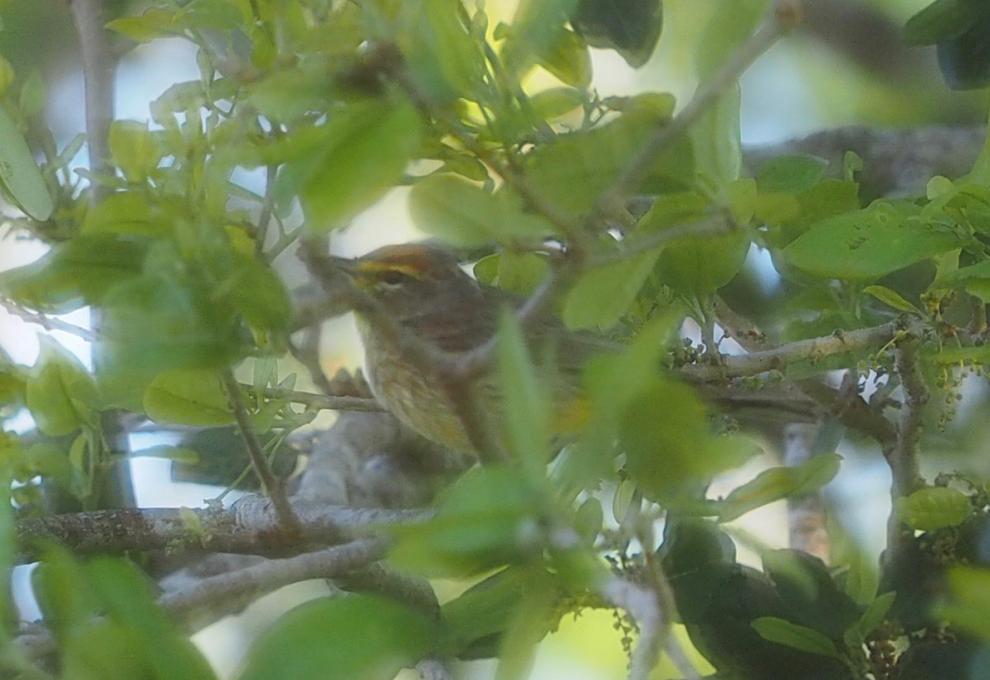 Palm Warbler
Palm Warbler
 Black and With Warbler
Black and With Warbler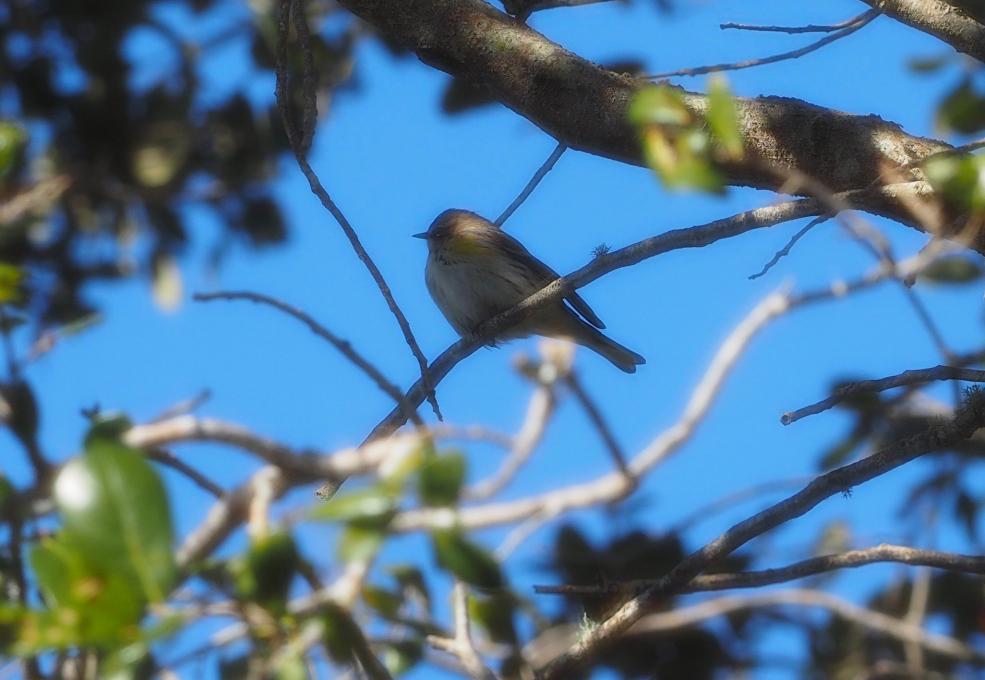 Yellow-rumped Warbler?
Different Seasons, Different Birds, Activity 2, Some who stay and some who only visit.
I am a “snowbird”. I have been a Florida resident for last 7 years who stays here in the winter and journeys north to MA for 5 months in the summer.
I noticed this year that my Live Oak trees right outside my lanai were full of small birds in Jan-March time frame but a little more-empty now that it is May. I looked through my pictures and also looked through the very long list Merlin provided to me and now better understand the reason. Some of the birds I found in the Warbler family were in the migration window when I saw them . They included a Palm Warbler, a Black and White Warbler and a Yellow Rumped Warbler or Common Yellowthroat. All show a presence in February and March and an absence in May
With the abundance of water and aquatic food, we have a wide variety of wading and fishing birds. The Great egret (my favorite) actually has a migrating population and a static population. I know Canada Geese have similar migrating and non migrating groups. Hence I can see Great Egrets all the time I am in FL and most of the time in MA. They seem to frequent a large portion of North and South America. It is hard from the animations in e-bird to see where the summer population in Massachusetts actually comes from. Most of my good bird books are in MA so I will have to do some digging to understand migration paths. One of the birds I see only rarely is the White Pelican (no good pictures) .. I have seen them in Ding Darling refuge on Sanibel and occasionally when fishing in Bonita Bay. E-bird shows a more complete picture of migration from concentrations in FL and more sparsely Mexico to South America in the winter and up the Mississippi valley to a broad part of the northern US, especially around the Great Lakes. Getting to know Merlin and e-bird has made it a lot faster to both identify and explore about birds than my long term reliance on field guides. Having participated in the Digital Revolution myself, I appreciate the immense improvements in information access for the birds.
Yellow-rumped Warbler?
Different Seasons, Different Birds, Activity 2, Some who stay and some who only visit.
I am a “snowbird”. I have been a Florida resident for last 7 years who stays here in the winter and journeys north to MA for 5 months in the summer.
I noticed this year that my Live Oak trees right outside my lanai were full of small birds in Jan-March time frame but a little more-empty now that it is May. I looked through my pictures and also looked through the very long list Merlin provided to me and now better understand the reason. Some of the birds I found in the Warbler family were in the migration window when I saw them . They included a Palm Warbler, a Black and White Warbler and a Yellow Rumped Warbler or Common Yellowthroat. All show a presence in February and March and an absence in May
With the abundance of water and aquatic food, we have a wide variety of wading and fishing birds. The Great egret (my favorite) actually has a migrating population and a static population. I know Canada Geese have similar migrating and non migrating groups. Hence I can see Great Egrets all the time I am in FL and most of the time in MA. They seem to frequent a large portion of North and South America. It is hard from the animations in e-bird to see where the summer population in Massachusetts actually comes from. Most of my good bird books are in MA so I will have to do some digging to understand migration paths. One of the birds I see only rarely is the White Pelican (no good pictures) .. I have seen them in Ding Darling refuge on Sanibel and occasionally when fishing in Bonita Bay. E-bird shows a more complete picture of migration from concentrations in FL and more sparsely Mexico to South America in the winter and up the Mississippi valley to a broad part of the northern US, especially around the Great Lakes. Getting to know Merlin and e-bird has made it a lot faster to both identify and explore about birds than my long term reliance on field guides. Having participated in the Digital Revolution myself, I appreciate the immense improvements in information access for the birds. 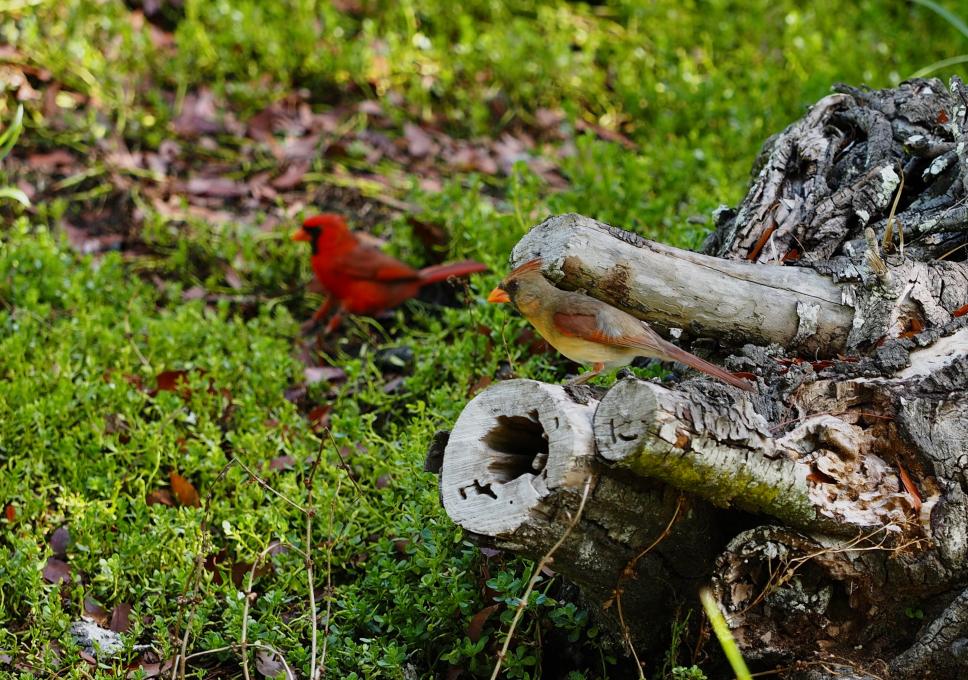 These cardinals probably stay in my neighborhood all year. They couple for life from my reading and are the species most likely to be able to photograph the male and female together around here.
Different Seasons Different Birds, Actvity 1, compare migrations of selected pairs
Northern Cardinal with Blackburnian Warbler
Northern Cardinal has a very static range. There are minor fluctuations around the fringes and within the main body of the population in the eastern 2/3 of the USA. There are also populations in southern CA, Nevada, Mexico (mostly coastal) and out into the Gulf coastal extensions of central America.
Blackburnian Warbler is a long migrator who moves from the tropical highlands of the northern parts of South America (south of where the Cardinal winters in what looks like somewhat cooler regions). And flies largely north of the heartland of the Cardinal’s range. They appear to overlap only in the summer in central to northern New England in the hillier parts of that region.
I can recommend a summer drive on route 100 through the middle of Vermont if you want to see some beautiful country and have a chance to see both birds.
Scarlet Tanager with Western Tanager
Scarlet Tanager and Western Tanager do an East West split on the United States. Their summer ranges give a reasonable wide birth to the central plains of the USA.. Western goes from west coast and highlands of Mexico and Central America in winter months to a broad swath of the Western USA and Western Provinces of Canada. The Scarlet goes further south into Western highlands of Bolivia Nicaragua and Equador and Western Brazil. It migrates north oove rCozumel and the western edge of Cuba over to Florida and settles in the northern 2/3 of the Eastern 1/3 of the US pretty much over a large part of the Applachian Trail. They seem to have very little overlap so it would be very rare to see the two in one location.
Ruby-throated Hummingbird with Rufous Hummingbird
Ruby-throated Hummingbird is the only hummingbird that makes its way to Massachusetts in the summer. I have one family that started visiting me the summer of 2018 when I was on my porch a lot due to radiation treatments and the recovery process. They had a single baby who I guessed was a female and loved my lantana. 2019 I added a feeder but am not sure they had a successful brood as I didn’t see the juvenile. They winter in Mexico and Central America and migrate to the whole eastern half of USA and most of southern Canada East of the Rockies. The Rufous winters in the northern half of the Ruby Throated’s range in Mexico but pretty much sticks to the Pacific coastal region for migration and breeding up in the Washington Oregon regions. Its path home looks to take a less coastal path visiting Idaho, Utah, Nevada, Arizona and New Mexico on its way back to Mexico wintering. Need to go Pacific side of Mexico below Baja to see them both in the winter.
Sandhill Crane with Yellow-bellied Flycatcher no confusing these.
Sandhill Crane sticks mostly to the USA and Canada including Alaska. It winters over in the US and travels to a brad swath of Canada in the breeding season. The flycatcher spends the winter in Central America and heads north mostly in the northeast USA and southeast Canada. A branch seems to take a brief trip to the eastern side of Alaska. Need to read more about them. To see both birds on the same trip one would have to go to southern Canada between the Great Lakes and Hudson Bay.
I really like the animation tool. I saw several warblers briefly in F this winter and now know it was migration time (March and April). That will set me up for Activity 2.
These cardinals probably stay in my neighborhood all year. They couple for life from my reading and are the species most likely to be able to photograph the male and female together around here.
Different Seasons Different Birds, Actvity 1, compare migrations of selected pairs
Northern Cardinal with Blackburnian Warbler
Northern Cardinal has a very static range. There are minor fluctuations around the fringes and within the main body of the population in the eastern 2/3 of the USA. There are also populations in southern CA, Nevada, Mexico (mostly coastal) and out into the Gulf coastal extensions of central America.
Blackburnian Warbler is a long migrator who moves from the tropical highlands of the northern parts of South America (south of where the Cardinal winters in what looks like somewhat cooler regions). And flies largely north of the heartland of the Cardinal’s range. They appear to overlap only in the summer in central to northern New England in the hillier parts of that region.
I can recommend a summer drive on route 100 through the middle of Vermont if you want to see some beautiful country and have a chance to see both birds.
Scarlet Tanager with Western Tanager
Scarlet Tanager and Western Tanager do an East West split on the United States. Their summer ranges give a reasonable wide birth to the central plains of the USA.. Western goes from west coast and highlands of Mexico and Central America in winter months to a broad swath of the Western USA and Western Provinces of Canada. The Scarlet goes further south into Western highlands of Bolivia Nicaragua and Equador and Western Brazil. It migrates north oove rCozumel and the western edge of Cuba over to Florida and settles in the northern 2/3 of the Eastern 1/3 of the US pretty much over a large part of the Applachian Trail. They seem to have very little overlap so it would be very rare to see the two in one location.
Ruby-throated Hummingbird with Rufous Hummingbird
Ruby-throated Hummingbird is the only hummingbird that makes its way to Massachusetts in the summer. I have one family that started visiting me the summer of 2018 when I was on my porch a lot due to radiation treatments and the recovery process. They had a single baby who I guessed was a female and loved my lantana. 2019 I added a feeder but am not sure they had a successful brood as I didn’t see the juvenile. They winter in Mexico and Central America and migrate to the whole eastern half of USA and most of southern Canada East of the Rockies. The Rufous winters in the northern half of the Ruby Throated’s range in Mexico but pretty much sticks to the Pacific coastal region for migration and breeding up in the Washington Oregon regions. Its path home looks to take a less coastal path visiting Idaho, Utah, Nevada, Arizona and New Mexico on its way back to Mexico wintering. Need to go Pacific side of Mexico below Baja to see them both in the winter.
Sandhill Crane with Yellow-bellied Flycatcher no confusing these.
Sandhill Crane sticks mostly to the USA and Canada including Alaska. It winters over in the US and travels to a brad swath of Canada in the breeding season. The flycatcher spends the winter in Central America and heads north mostly in the northeast USA and southeast Canada. A branch seems to take a brief trip to the eastern side of Alaska. Need to read more about them. To see both birds on the same trip one would have to go to southern Canada between the Great Lakes and Hudson Bay.
I really like the animation tool. I saw several warblers briefly in F this winter and now know it was migration time (March and April). That will set me up for Activity 2. ![20200514_194052[1]](https://academy.allaboutbirds.org/wp-content/uploads/hm_bbpui/701567/Tfx9x4i78dfxi02xgc1pzj3h4t4jtawz2.jpg)
![20200514_175330[1]](https://academy.allaboutbirds.org/wp-content/uploads/hm_bbpui/701567/T2bjlafj5zhyscrpr8ohfw7484mc1igcb.jpg)
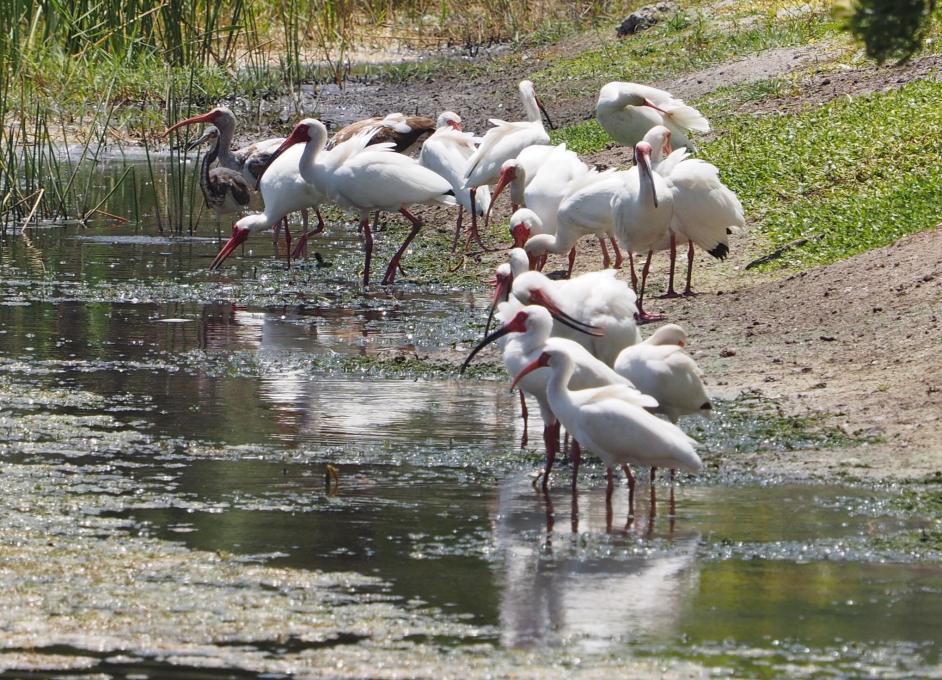
 These activities tasked us to more fully explore the e-Bird site. (Activity 1) The Sandhill crane was just sited by my daughter traveling north from 200 miles away. We tracked the migration pattern and noted why we have to travel from our home to see them. (Activity 2) Black-capped chickadees, woodpeckers, & dark-eyed juncos are in abundance year round in our neighborhood. Whereas mallards, trumpeter swans, and Canadian Geese are seasonal residents. The latter seem to take ownership of most urban parks in Minnesota Spring, Summer, & Fall. We visited a National Wildlife Refuge Center this past week to spot the migrating mallards, hawks, turkey vultures, American White Pelicans, Cliff/ Barn, or Tree Swallows (they flit around too fast to note differences!), blue jays, and ruffed grouse. (Activity 3) The Macaulay Library opened our eyes to the seasonal differences in one particular bird whereas we'd previously noted only male/female differences.
These activities tasked us to more fully explore the e-Bird site. (Activity 1) The Sandhill crane was just sited by my daughter traveling north from 200 miles away. We tracked the migration pattern and noted why we have to travel from our home to see them. (Activity 2) Black-capped chickadees, woodpeckers, & dark-eyed juncos are in abundance year round in our neighborhood. Whereas mallards, trumpeter swans, and Canadian Geese are seasonal residents. The latter seem to take ownership of most urban parks in Minnesota Spring, Summer, & Fall. We visited a National Wildlife Refuge Center this past week to spot the migrating mallards, hawks, turkey vultures, American White Pelicans, Cliff/ Barn, or Tree Swallows (they flit around too fast to note differences!), blue jays, and ruffed grouse. (Activity 3) The Macaulay Library opened our eyes to the seasonal differences in one particular bird whereas we'd previously noted only male/female differences. 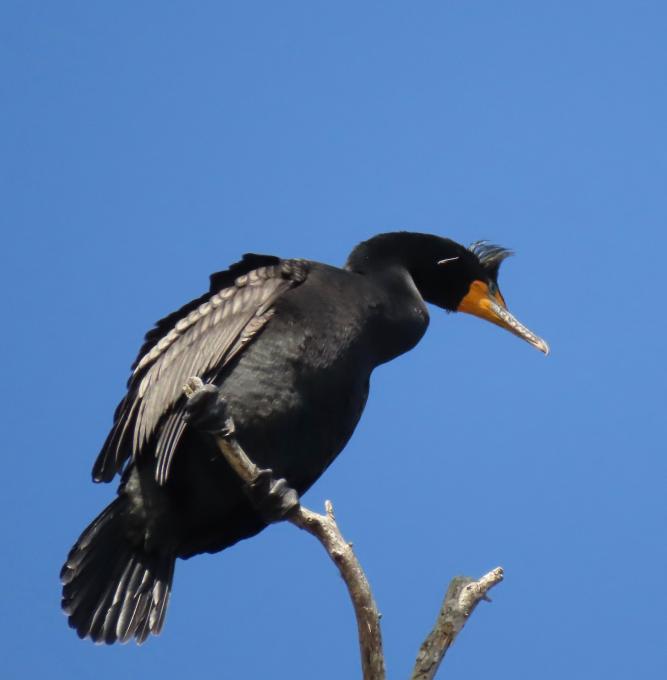
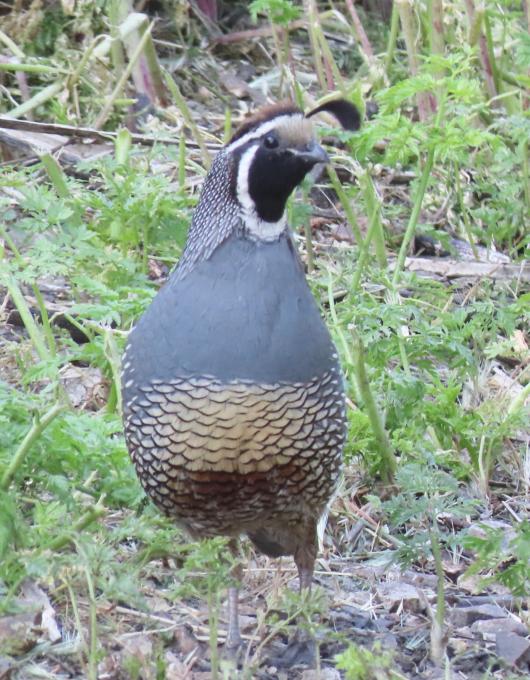
 The White-crowned Sparrow, the Double-crested Cormorant, and the California Quail are all ubiquitous where I live. I was surprised that the California Quail seems to be the least common bird of the three. I learned that it is also found in South America in an area that has a similar climate. The Double-crested Cormorant is found all over the country and I had assumed that it was a bird only found near the ocean. The White-crowned Sparrow is pretty common, but seems to follow the warmer weather.
The White-crowned Sparrow, the Double-crested Cormorant, and the California Quail are all ubiquitous where I live. I was surprised that the California Quail seems to be the least common bird of the three. I learned that it is also found in South America in an area that has a similar climate. The Double-crested Cormorant is found all over the country and I had assumed that it was a bird only found near the ocean. The White-crowned Sparrow is pretty common, but seems to follow the warmer weather. 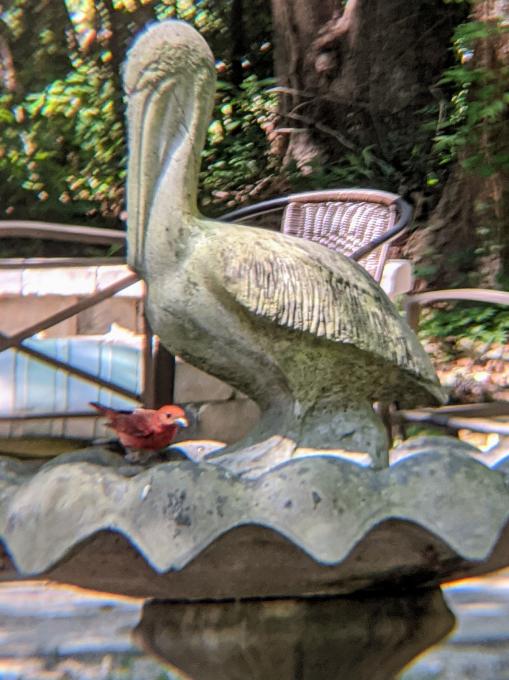 Activity 4: My favorite birding spot is also the easiest for me - my backyard! Six months from now, I'll still see cardinals, crows, and woodpeckers, but my hummingbird friends will likely be all (or mostly) gone for the season. There is a also a Summer Tanager visiting right now who will be wintering in Central or South America. I am definitely enjoying watching him for now though!
Activity 4: My favorite birding spot is also the easiest for me - my backyard! Six months from now, I'll still see cardinals, crows, and woodpeckers, but my hummingbird friends will likely be all (or mostly) gone for the season. There is a also a Summer Tanager visiting right now who will be wintering in Central or South America. I am definitely enjoying watching him for now though! 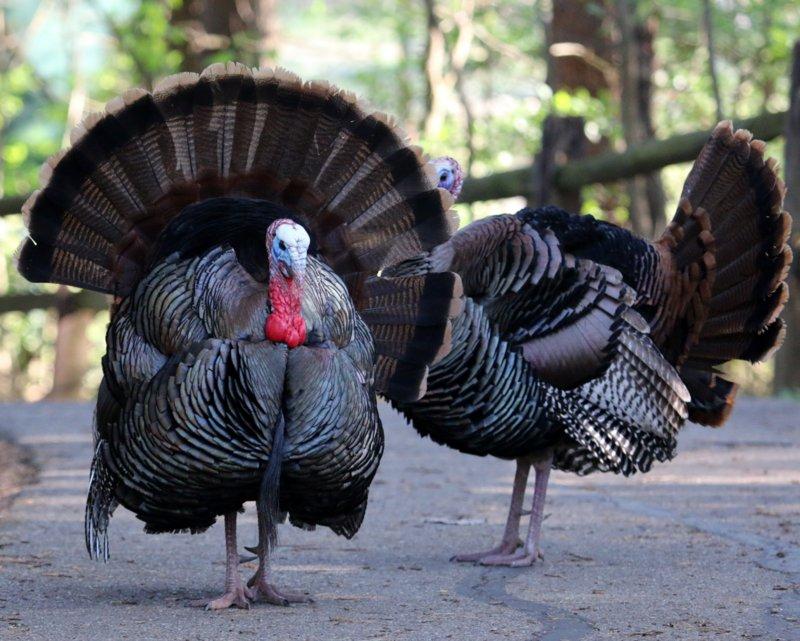
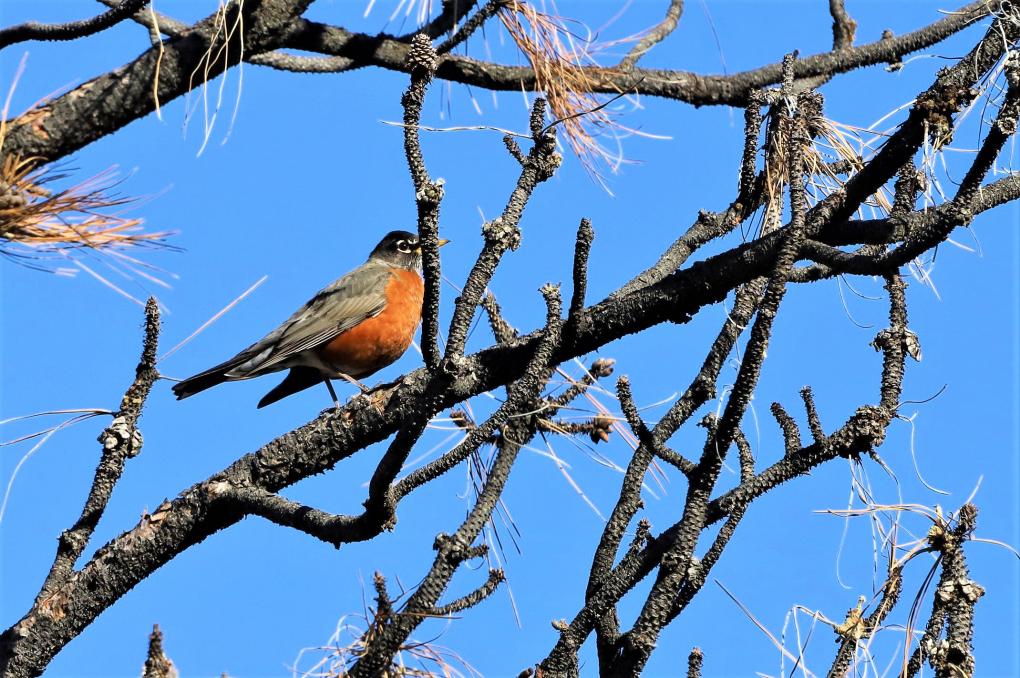
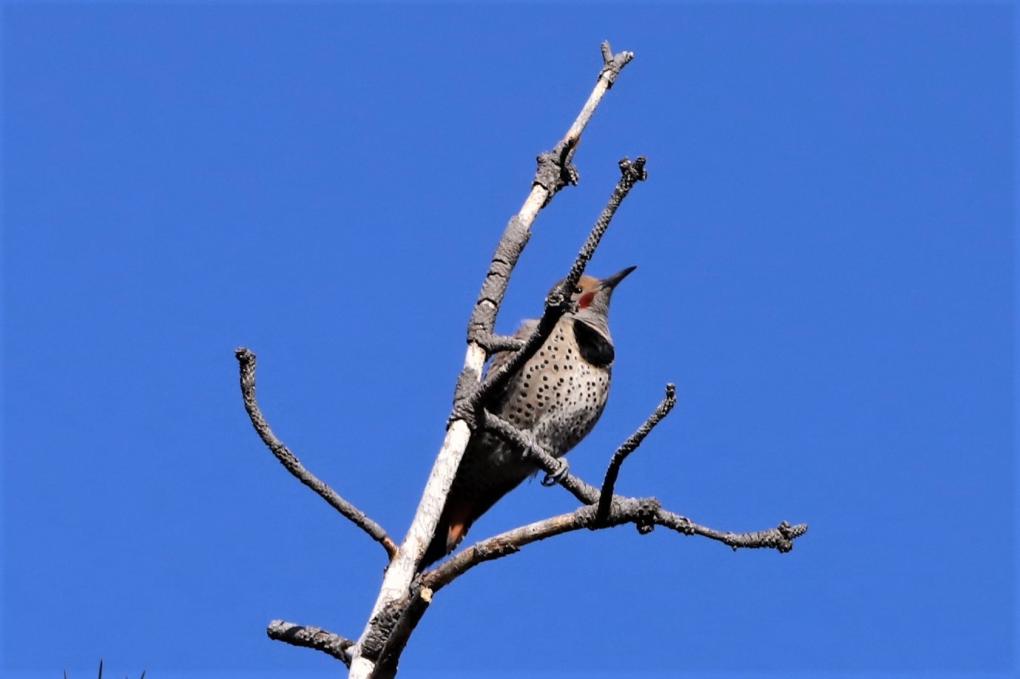
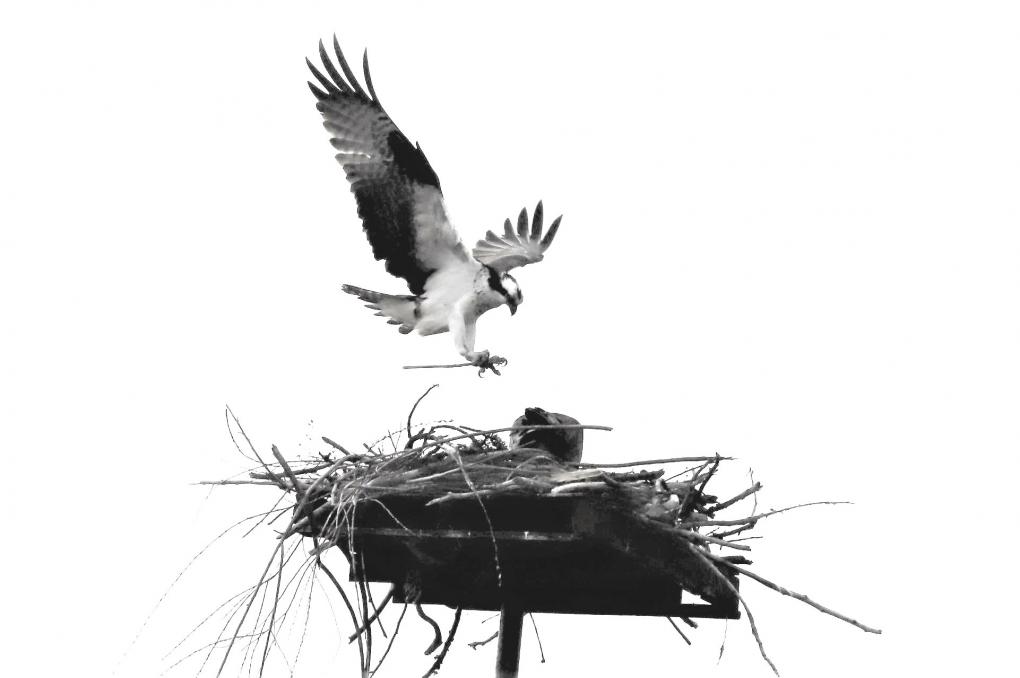

 Activity 3: It is incredible the difference in colors in different seasons. It makes sense that many birds are less colorful in the winter for camouflage. We do not have either species in our area in the winter. It is interesting that the males are more colorful than females in summer. The color and markings are so vibrant, and I guess pleasing to the females. Is it also that birds in colder winter climates have extra feathers to keep warm? It would make sense. I am going to look that up. In the human race it is the females that decorate to attract males. Funny.
Activity 3: It is incredible the difference in colors in different seasons. It makes sense that many birds are less colorful in the winter for camouflage. We do not have either species in our area in the winter. It is interesting that the males are more colorful than females in summer. The color and markings are so vibrant, and I guess pleasing to the females. Is it also that birds in colder winter climates have extra feathers to keep warm? It would make sense. I am going to look that up. In the human race it is the females that decorate to attract males. Funny.